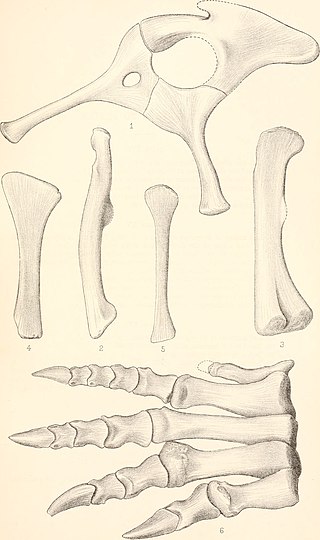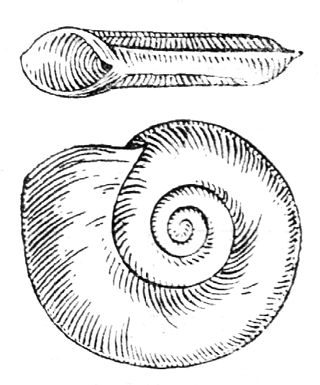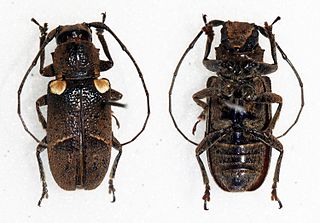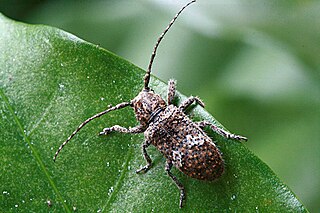
Echis carinatus, known as the saw-scaled viper, Indian saw-scaled viper, little Indian viper, and by other common names, is a viper species found in parts of the Middle East and Central Asia, and especially the Indian subcontinent. It is the smallest member of the "big four" Indian snakes that are responsible for causing the most snakebite cases and deaths, due to various factors including their frequent occurrence in highly populated regions, and their inconspicuous nature. Like all vipers, the species is venomous. Two subspecies are currently recognized, including the nominate subspecies described here.

Massospondylus was a genus of sauropodomorph dinosaur from the Early Jurassic. It was described by Sir Richard Owen in 1854 from remains discovered in South Africa, and is thus one of the first dinosaurs to have been named. Fossils have since been found at other locations in South Africa, Lesotho, and Zimbabwe. Material from Arizona's Kayenta Formation, India, and Argentina has been assigned to the genus at various times, but the Arizonan and Argentinian material are now assigned to other genera.

Gryponyx is an extinct genus of massopod sauropodomorph known from southern Free State, central South Africa.

Plateosauridae is a family of plateosaurian sauropodomorphs from the Late Triassic of Europe, Greenland, Africa and Asia. Although several dinosaurs have been classified as plateosaurids over the years, the family Plateosauridae is now restricted to Plateosaurus, Yimenosaurus, Euskelosaurus, and Issi. In another study, Yates (2003) sunk Sellosaurus into Plateosaurus. Gresslyosaurus is alternatively considered its own genus or a synonym of Plateosaurus.

Sternotherus is a genus of turtles in the family Kinosternidae including six species commonly known as musk turtles. The genus is endemic to North America, occurring in the eastern third of the US and southeast Ontario, Canada. Musk glands positioned near the bridge of the shell can produce foul smelling secretions when the turtles are threatened, although gentle handling does not normally provoke a response. Sternotherus are moderately small turtles, with the largest species in the genus, the razor-backed musk turtle, attaining a maximum of 17.6 cm. in shell length. The carapace is characteristically oval and domed, with most species having one or three keels on the back which may become smoother and obscure with age in some species. Musk turtles are generally drab in color, mostly black, gray, brown, olive, or ocher, which aid in camouflaging them in their natural habitats. The head is relatively large and stout, marked with spots, streaks, or strips. The plastron has only 10 or 11 scutes, as opposed to 12, a more common condition in North American turtles. The tail is short, with males having a horny claw like tip.

The razor-backed musk turtle is a species of turtle in the family Kinosternidae. The species is native to the southern United States. There are no subspecies that are recognized as being valid.

Planorbis carinatus is species of air-breathing freshwater snail, a pulmonate gastropod mollusk in the family Planorbidae, the ramshorn snails.

Leiocephalus carinatus, commonly known as the northern curly-tailed lizard or saw-scaled curlytail, is a species of lizard in the family Leiocephalidae.

Bromus carinatus is a species of brome grass known by the common names California brome and mountain brome.

Abax carinatus is a species of woodland ground beetle in the family Carabidae. It is found in the Palearctic.
The African keeled mud turtle is a species of turtle in the family Pelomedusidae. It is endemic to central Africa : the Democratic Republic of the Congo, the Republic of the Congo, and Gabon.
Copelatus carinatus is a species of diving beetle. It is part of the genus Copelatus of the subfamily Copelatinae in the family Dytiscidae. It was described by Sharp in 1882.

Prosoplus is a genus of longhorn beetles of the subfamily Lamiinae, containing the following species:
Prosoplus atlanticus is a species of beetle in the family Cerambycidae. It was described by Stephan von Breuning in 1938.

Rhytiphora bankii is a species of beetle in the family Cerambycidae. It was first described by Johan Christian Fabricius in 1775, under the genus Lamia. It is known from Australia, the Philippines, Borneo, Java, Micronesia, New Guinea, Hawaii, Moluccas, Sumatra, Vietnam, and has been introduced into Japan. The Australian species of Prosoplus were synonymised with Rhytiphora in 2013.
Prosoplus dentatus is a species of beetle in the family Cerambycidae. It was described by Guillaume-Antoine Olivier in 1792. It is known from Mauritius, Seychelles, Réunion, and Madagascar. It contains the varietas Prosoplus dentatus var. ochreomaculatus.
Prosoplus lividus is a species of beetle in the family Cerambycidae. It was described by Masaki Matsushita in 1935.
Prosoplus sinuatofasciatus is a species of beetle in the family Cerambycidae. It was described by Blanchard in 1855.

Ngwevu is a genus of massospondylid sauropodomorph dinosaur from the Lower Jurassic of South Africa. The genus contains one species, Ngwevu intloko.

Collatus is a genus of very small and minute sea snails with an operculum, marine gastropod mollusks in the family Vitrinellidae.













